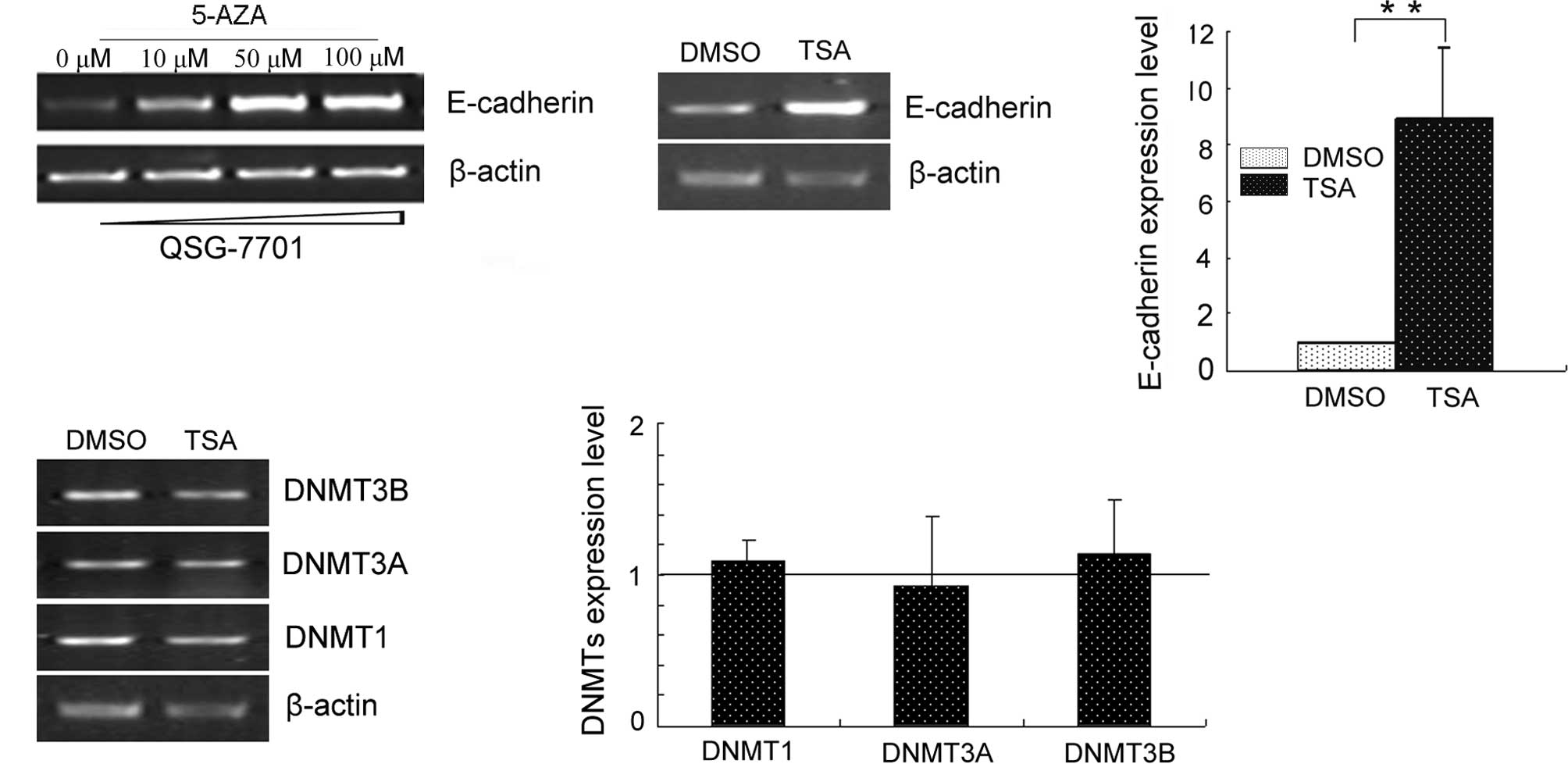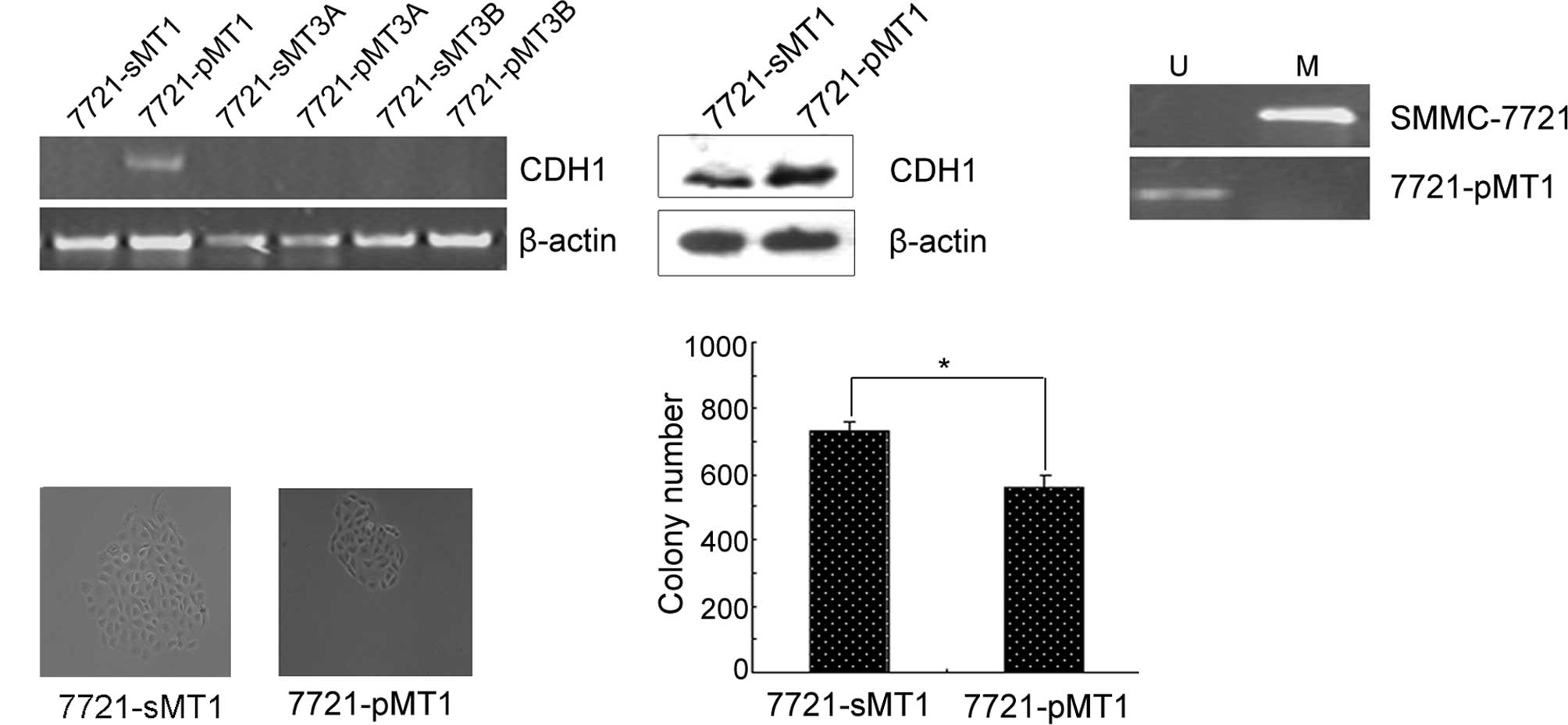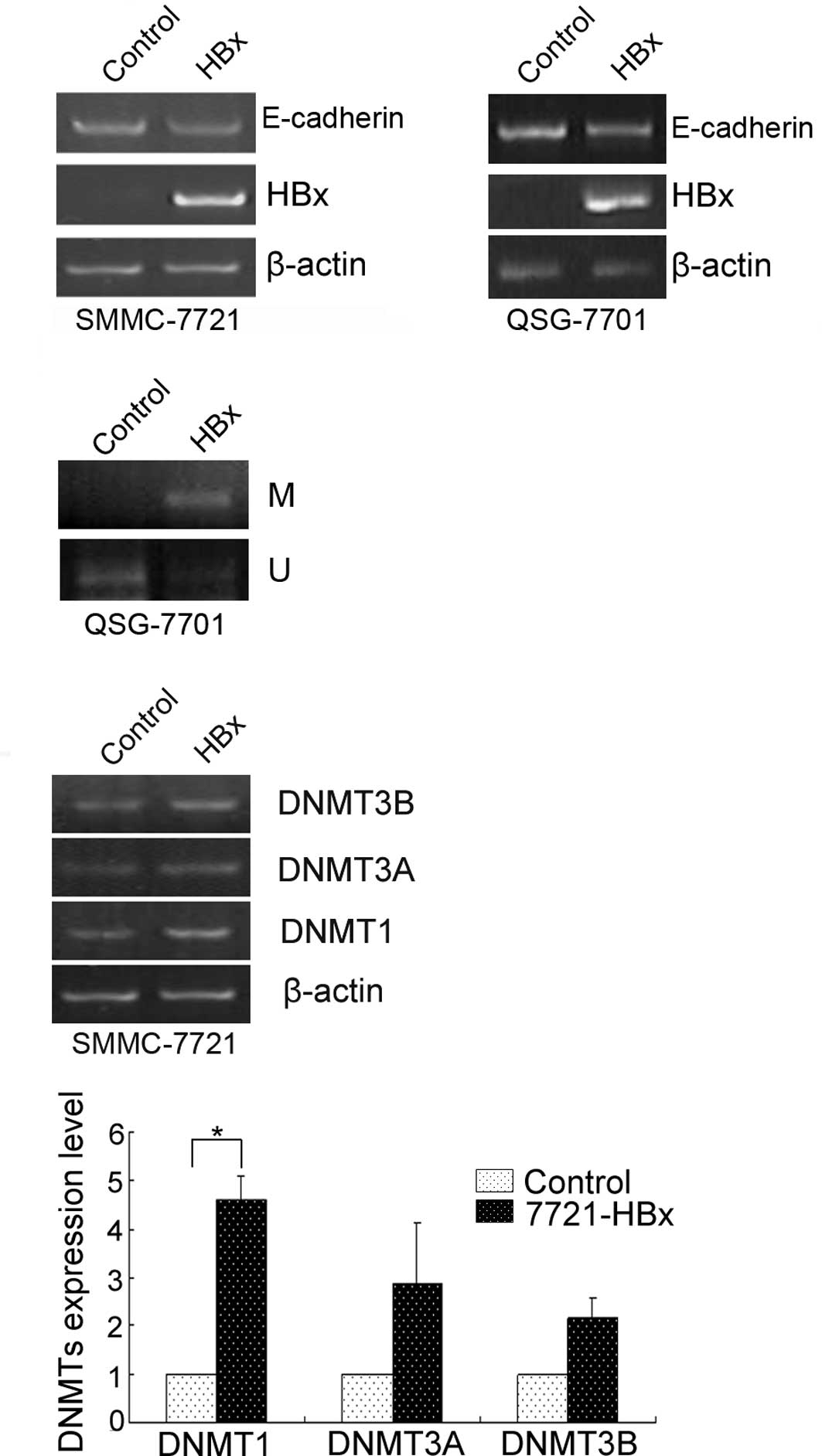Epigenetic activation of E-cadherin is a candidate therapeutic target in human hepatocellular carcinoma
- Authors:
- Published online on: May 1, 2010 https://doi.org/10.3892/etm_00000082
- Pages: 519-523
Abstract
Introduction
E-cadherin (CDH1) is a well-known suppressor of invasion/metastasis and an important Ca2+-dependent adhesion molecule that mediates cell-cell contact and is important for tissue morphogenesis and cell polarity (1). Owing to its critical function in intercellular adhesion, E-cadherin has been assumed to act as a tumor suppressor negatively regulating several critical steps of invasion and metastasis (2). E-cadherin expression is frequently suppressed or reduced in carcinoma tissues of the breast and liver and in many carcinoma cell lines derived from the colon, stomach and prostate (3). The loss of E-cadherin function induced by promoter methylation was associated with the metastasis and invasion of tumors. Studies using animal models and human hepatocellular carcinoma (HCC) tissues have shown that hypermethylation is associated with decreased E-cadherin expression but also with microvascular invasion and recurrence of HCC (4,5). Transcriptional or post-transcriptional down-regulation may be the mechanism of underexpression of E-cadherin in HCC (6). The decrease or loss of E-cadherin expression is observed in HCC as well, particularly in poorly differentiated cancers (7,8). E-cadherin plays a role in cancer progression, and its therapeutic restoration as a strategy to suppress metastasis has recently been considered (9). The presence of the HBx protein, which is one of the crucial factors in HCC, was found to be involved in this pathway and may be associated with the hypermethylation of the E-cadherin promoter (10).
Over the past few years, many epigenetic drugs have been discovered and found to effectively reverse DNA methylation and histone modification aberrations that occur in cancer (11). 5-Azacytidine (5′-aza) and 5-aza-2′-deoxycytidine lead to the inhibition of DNA methylation and induce gene expression via the blocking of DNA methyltransferases (DNMTs). Trichostatin A (TSA), one of the effective HDAC inhibitors, re-establishes normal histone acetylation patterns and reactivates silenced tumor suppressor genes. These discoveries have led to the possibility of ‘epigenetic therapy’ as a treatment option, and epigenetic agents are defined as a legitimate set of targets for therapeutic approaches to cancer. In the present study, we investigated E-cadherin-up-regulating drugs, proposing a schema for restoring E-cadherin by targeting its epigenetic mechanism.
Materials and methods
Cell culture and 5′-aza/TSA treatment
The human HCC cell line SMMC-7721 and human hepatocellular pericarcinoma cell line QSG-7701 (Cell Bank Shanghai, P.R. China) were maintained by serial passage in RPMI-1640 (Gibco, USA) containing 10% heat-inactivated newborn bovine serum, and incubated at 37°C in an atmosphere containing 5% CO2. Cells were cultured in medium containing 120 ng/ml of TSA (Sigma, USA) or DMSO for 24 h. For 5′-aza (Sigma) treatment, cells were plated and treated with 0, 10, 50 and 100 μmol/l 5′-aza for up to 2 days.
Transfection of DNMT1 siRNA, DNMT3A siRNA and DNMT3B siRNA into the HCC cell line SMMC-7721
SMMC-7721 cells were transfected with DNMT1 siRNA (pMT1), DNMT3A siRNA (pMT3A) and DNMT3B siRNA (pMT3B) constructs, and their scramble sequences as control, respectively, using Transfectamine™ 2000 transfection reagent (Invitrogen, USA) as in our previous studies (12,13). Cells were grown and selectively cultured in 0.4 mg/ml Geneticin (Life Technologies, USA) for 2 months after the initial transfection. SMMC-7721 cells transfected with pMT1, pMT3A and pMT3B were labeled as 7721-pMT1, 7721-pMT3A and 7721-pMT3B; those transfected with DNMT scramble sequence were labeled as 7721-sMT1, 7721-sMT3A and 7721-sMT3B.
Semi-quantitative reverse transcription-PCR (RT-PCR)-detected expression of genes
The expression of the tumor suppressor gene E-cadherin and of DNMTs was analyzed by semi-quantitative RT-PCR. Total RNA was purified with TRIzol (Invitrogen). First-strand complementary DNA (cDNA) was synthesized from 2 μg of total RNA using Oligo(dT)18 primer and M-MLV reverse transcriptase (Invitrogen). β-actin was used as an internal control. Each PCR was repeated with at least three different cDNA preparations and three independent PCRs for each cDNA with β-actin co-amplification. The primer sequence of each gene and the PCR conditions are listed in Table I.
Antibody and Western blotting
The protein concentration of each extract was quantitated using the BCA assay (Pierce, USA). Total protein (2–40 μl) was electrophoresed on 7–15% SDS-polyacrylamide gel and transferred to polyvinylidene fluoride membranes (PVDF; Amersham) electrophoretically. Western blotting was performed with the mouse monoclonal anti-E-cadherin or the mouse monoclonal anti-β-actin (Sigma) antibodies and detected by Super Signal chemiluminescence substrate (Pierce). β-actin protein levels were used as a control for equal protein loading.
Methyl-specific PCR (MSP) for promoters of E-cadherin
Genomic DNA was obtained from cell lines and modified with sodium bisulfite as described previously (14). Sodium bisulfite-treated genomic DNA from 7721-sMT1 and 7721-pMT1 were specifically amplified by methylated and unmethylated primers of E-cadherin as reported previously (15).
Colony formation assay
Cells (1×103) were evenly plated onto 6-well plates in medium containing 10% FBS and incubated at 37°C in 5% CO2. After 14 days of incubation, colony growth on the plates was assayed by the visual counting of the colonies. Cells were then fixed in methanol and stained using crystal violet solution to evaluate foci formation. Experiments were performed in triplicate during two independent repetitions.
Transfection with HBx construct
Cells were transfected with 4 μg of the pcDNA4/TO-HBx construct (a gift from Professor X.Y. Guan, University of Hong Kong) and the control pcDNA4/TO using Lipofectamine™ 2000 transfection reagent (Invitrogen) for 36 h.
Results
Treatment with 5′-aza/TSA up-regulates E-cadherin expression
After cells were treated with 5′-aza or TSA, semi-quantitative RT-PCR was performed on E-cadherin expression (Fig. 1). Both 5′-aza and TSA treatments up-regulated E-cadherin expression. 5′-aza restored E-cadherin in a dose-dependent manner. TSA-regulated E-cadherin expression did not occur through DNMTs.
Depletion of DNMT1 induced E-cadherin expression via demethylation of the promoter
In order to determine which DNMTs play a major role in reducing the expression of E-cadherin, we detected the expression of E-cadherin in 7721-pMT1, 7721-pMT3A and 7721-pMT3B cells. RT-PCR results showed that the knockdown of DNMT1 restored E-cadherin expression, whereas the knockdown of DNMT3A or DNMT3B did not (Fig. 2A). In DNMT1-depleted HCC cells, E-cadherin expression was upregulated at the protein level and coincided with the transcriptional level. These results indicated that the E-cadherin gene may be one of the direct targets of DNMT1. We next investigated whether the up-regulated expression of E-cadherin induced by DNMT1 RNAi would be reflected in the promoter methylation status of the genes. Therefore, we determined the methylation status of the promoter using MSP as shown in Fig. 2B. The results showed that the restoration of E-cadherin was significantly associated with its promoter demethylation in the 7721-pMT1 cell line. Subsequently, colony formation assays were performed using the 7721-pMT1 and control cell lines. Compared to the random control, siRNA-treated HCC cells with knocked down DNMT1 expression exhibited a significantly decreased colony size in the colony formation assays (Fig. 2C).
HBx leads to the promoter hypermethylation of the E-cadherin gene by activating DNA methyltransferase-1
Previous immunohistochemical studies of E-cadherin expression in HBV-related HCC have demonstrated the significant down-regulation of E-cadherin expression in tumor tissues compared with adjacent non-tumor tissues (16). Although the pathogenesis of HBV-related HCC has not been fully described, evidence suggests that HBx plays a crucial role in the pathogenesis of HCC (17). Therefore, we first investigated whether HBx represses E-cadherin expression in cultured human liver cells. For this purpose, we transfected the transiently pcDNA4/TO-HBx construct into QSG-7701 and SMMC-7721 cells. As a result, the E-cadherin mRNA level was reduced by HBx (Fig. 3A), suggesting that HBx represses E-cadherin expression. The repression of E-cadherin by HBx was significantly associated with its promoter methylation (Fig. 3B) and increased DNMT1 (Fig. 3C).
Discussion
It has been suggested that genetic alterations such as loss of heterozygosity and mutations in tumor suppressor genes accumulate during multistep hepatocarcinogenesis (18,19). Recently, epigenetic alterations including histone deacetylation and DNA methylation in promoter areas were also hypothesized to play crucial roles in the development of HCC. DNA methylation inhibitors including 5′-aza induce gene expression. 5′-aza was the first epigenetic drug proposed for use in cancer therapeutics (20). TSA alone or in combination with 5′-aza is capable of reactivating the transcription of tumor suppressor genes that are silenced by methylation-mediated mechanisms in human cancer cells (21,22). A number of genes involved in cell cycle- or apoptosis-regulation were also up-regulated in hepatoma cell lines, as previously reported (23).
Hypermethylation of CpG regions of the E-cadherin promoter represents the most common cause for its inactivation and has been observed in many malignancies, including HCC (24–27). Reactivation of E-cadherin, proposed as a target of epigenetic therapy for tumors (28), may be effective in HCC. In the present study, we investigated for the first time the epigenetic activation of E-cadherin by treatment with 5′-aza in an HCC cell line, and found it to be dependent on the administered dose of 5′-aza. Several studies have suggested that 5′-aza restores the expression of silenced genes by selective degradation or the partial influence of DNMT1 (30,31). In our study, we found that the depletion of DNMT1 restored E-cadherin gene expression by demethylating the promoter and suppressed HCC cell colony formation.
As HBV is the main factor leading to HCC in Chinese populations (29), HBx, an important gene associated with HBV, was transfected into HCC cells to evaluate the potential cause of inactivated E-cadherin in HCC samples from Chinese patients. It was observed that some of the tumor-associated genes, including IGFBP3, were epigenetically silenced in HCC cell lines infected with the recombinant HBx (32,33). This preliminary observation led to further in vivo and in vitro analyses of this characteristic abnormality of HBV-associated HCC. Few studies have focused on the mechanisms of the promoter methylation of host genes in association with HBV infection. Here, we showed that HBx suppressed expression of the E-cadherin gene by activating DNMT1. Our study regarding the epigenetic modulation of E-cadherin by HBx may suggest a mechanism for the epigenetic silencing of tumor suppressor genes in HBV-related HCC.
The findings presented in the present study demonstrate that diverse epigenetic agents restore E-cadherin expression. In addition, results obtained from studies involving HBx-transfected HCC cell lines suggest that the inhibition of DNMT1 may be considered a strategy by which silenced E-cadherin in HBV-related HCC may be inactivated.
Acknowledgements
The present study was supported by the National Natural Science Foundation of China (nos. 30470950 and 30971605). We thank Dr Wu Dianqing for providing the pSUPER-EGFP.
References
|
Takeichi M: Cadherin cell adhesion receptors as a morphogenetic regulator. Science. 251:1451–1455. 1991. View Article : Google Scholar : PubMed/NCBI | |
|
Hirohashi S and Kanai Y: Cell adhesion system and human cancer morphogenesis. Cancer Sci. 94:575–581. 2003. View Article : Google Scholar : PubMed/NCBI | |
|
Momparler RL and Bovenzi V: DNA methylation and cancer. J Cell Physiol. 183:145–154. 2000. View Article : Google Scholar | |
|
Hazan RB, Qiao R, Keren R, Badano I and Suyama K: Cadherin switch in tumor progression. Ann NY Acad Sci. 1014:155–163. 2004. View Article : Google Scholar : PubMed/NCBI | |
|
Calvisi DF, Ladu S, Conner EA, Factor VM and Thorgeirsson SS: Disregulation of E-cadherin in transgenic mouse models of liver cancer. Lab Invest. 84:1137–1147. 2004. View Article : Google Scholar : PubMed/NCBI | |
|
Huang GT, Lee HS, Chen CH, Sheu JC, Chiou LL and Chen DS: Correlation of E-cadherin expression and recurrence of hepatocellular carcinoma. Hepatogastroenterology. 46:1923–1927. 1999.PubMed/NCBI | |
|
Wei Y, van Nhieu JT, Prigent S, Srivatanakul P, Tiollais P and Buendia MA: Altered expression of E-cadherin in hepatocellular carcinoma: correlations with genetic alterations, beta-catenin expression and clinical features. Hepatology. 36:692–701. 2002. View Article : Google Scholar : PubMed/NCBI | |
|
Ihara A, Koizumi H, Hashizume R and Uchikoshi T: Expression of epithelial cadherin and alpha- and beta-catenins in nontumoral livers and hepatocellular carcinoma. Hepatology. 23:1441–1447. 1996.PubMed/NCBI | |
|
Howard EW, Camm KD, Wong YC and Wang XH: E-cadherin upregulation as a therapeutic goal in cancer treatment. Mini Rev Med Chem. 8:496–518. 2008. View Article : Google Scholar : PubMed/NCBI | |
|
Liu J, Lian Z, Han S, Waye MM, Wang H, Wu MC, Wu K, Ding J, Arbuthnot P, Kew M, Fan D and Feitelson MA: Downregulation of E-cadherin by hepatitis B virus X antigen in hepatocellullar carcinoma. Oncogene. 25:1008–1017. 2006. View Article : Google Scholar : PubMed/NCBI | |
|
Yoo CB and Jones PA: Epigenetic therapy of cancer: past, present and future. Nat Rev Drug Discov. 5:37–50. 2006. View Article : Google Scholar : PubMed/NCBI | |
|
Fan H, Zhao Z, Quan Y, Xu J, Zhang J and Xie W: DNA methyltransferase 1 knockdown induces silenced CDH1 gene reexpression by demethylation of methylated CpG in hepatocellular carcinoma cell line SMMC-7721. Eur J Gastroenterol Hepatol. 19:952–961. 2007. View Article : Google Scholar : PubMed/NCBI | |
|
Xu J, Fan H, Zhao ZJ, Zhang JQ and Xie W: Identification of potential genes regulated by DNA methyltransferase 3B in a hepatocellular carcinoma cell line by RNA interference and microarray analysis. Yi Chuan Xue Bao. 32:1115–1127. 2005.PubMed/NCBI | |
|
Herman JG, Graff JR, Myohanen S, Nelkin BD and Baylin SB: Methylation-specific PCR: a novel PCR assay for methylation status of CpG islands. Proc Natl Acad Sci USA. 93:9821–9826. 1996. View Article : Google Scholar : PubMed/NCBI | |
|
Zhang H, Xiao W, Liang H, Fang D, Yang S and Luo Y: Demethylation in the promoter area by the antisense of human DNA MTase gene. Zhonghua Zhong Liu Za Zhi. 24:444–447. 2002.PubMed/NCBI | |
|
Kanai Y, Ushijima S, Hui AM, Ochiai A, Tsuda H, Sakamoto M and Hirohashi S: The E-cadherin gene is silenced by CpG methylation in human hepatocellular carcinomas. Int J Cancer. 71:355–359. 1997. View Article : Google Scholar : PubMed/NCBI | |
|
Feitelson M: Hepatitis B virus infection and primary hepatocellular carcinoma. Clin Microbiol Rev. 5:275–301. 1992.PubMed/NCBI | |
|
Murakami Y, Hayashi K and Sekiya T: Aberration of the tumor suppressor p53 and retinoblastoma in human hepatocellular carcinomas. Cancer Res. 51:5520–5525. 1991.PubMed/NCBI | |
|
Liao C, Zhao M, Song H, Uchida K, Yokoyama KK and Li T: Identification of the gene for a novel liver-related putative tumor suppressor at a high-frequency loss of heterozygosity region of chromosome 8p23 in human hepatocellular carcinoma. Hepatology. 32:721–727. 2000. View Article : Google Scholar : PubMed/NCBI | |
|
Constantinides PG, Jones PA and Gevers W: Functional striated muscle cells from non-myoblast precursors following 5-azacytidine treatment. Nature. 267:364–366. 1977. View Article : Google Scholar : PubMed/NCBI | |
|
Yoshida M, Horinouchi S and Beppu T: Trichostatin A and trapoxin: novel chemical probes for the role of histone acetylation in chromatin structure and function. Bioessays. 17:423–430. 1995. View Article : Google Scholar : PubMed/NCBI | |
|
Zhu WG and Otterson GA: The interaction of histone deacetylase inhibitors and DNA methyltransferase inhibitors in the treatment of human cancer cells. Curr Med Chem Anti-Cancer Agents. 3:187–199. 2003. View Article : Google Scholar : PubMed/NCBI | |
|
Chiba T, Yokosuka O, Arai M, Tada M, Fukai K, Imazeki F, Kato M, Seki N and Saisho H: Identification of genes up-regulated by histone deacetylase inhibition with cDNA microarray and exploration of epigenetic alterations on hepatoma cells. J Hepatol. 41:436–445. 2004. View Article : Google Scholar : PubMed/NCBI | |
|
Berx G, Cleton-Jansen AM, Strumane K, de Leeuw WJ, Nollet F, van Roy F and Cornelisse C: E-cadherin is inactivated in a majority of invasive human lobular breast cancers by truncation mutations throughout its extracellular domain. Oncogene. 13:1919–1925. 1996. | |
|
Melki JR, Vincent PC, Brown RD and Clark SJ: Hypermethylation of E-cadherin in leukemia. Blood. 95:3208–3213. 2000.PubMed/NCBI | |
|
Tamura G, Yin J, Wang S, et al: E-cadherin gene promoter hypermethylation in primary human gastric carcinomas. J Natl Cancer Inst. 92:569–573. 2000. View Article : Google Scholar : PubMed/NCBI | |
|
Iwata N, Yamamoto H, Sasaki S, Itoh F, Suzuki H, Kikuchi T, Kaneto H, Iku S, Ozeki I, Karino Y, Satoh T, Toyota J, Satoh M, Endo T and Imai K: Frequent hypermethylation of CpG islands and loss of expression of the 14-3-3 sigma gene in human hepatocellular carcinoma. Oncogene. 19:5298–5302. 2000. View Article : Google Scholar : PubMed/NCBI | |
|
Nam JS, Ino Y, Kanai Y, Sakamoto M and Hirohashi S: 5-aza-2′-deoxycytidine restores the E-cadherin system in E-cadherin-silenced cancer cells and reduces cancer metastasis. Clin Exp Metastasis. 21:49–56. 2004. | |
|
Yu MC, Yuan JM, Govindarajan S and Ross RK: Epidemiology of hepatocellular carcinoma. Can J Gastroenterol. 14:703–709. 2000.PubMed/NCBI | |
|
Ghoshal K, Datta J, Majumder S, Bai S, Kutay H, Motiwala T and Jacob ST: 5-Aza-deoxycytidine induces selective degradation of DNA methyltransferase 1 by a proteasomal pathway that requires the KEN box, bromo-adjacent homology domain and nuclear localization signal. Mol Cell Biol. 25:4727–4741. 2005. View Article : Google Scholar | |
|
Palii SS, van Emburgh BO, Sankpal UT, Brown KD and Robertson KD: DNA methylation inhibitor 5-Aza-2′-deoxycytidine induces reversible genome-wide DNA damage that is distinctly influenced by DNA methyltransferases 1 and 3B. Mol Cell Biol. 28:752–771. 2008. | |
|
Park IY, Sohn BH, Yu E, Suh DJ, Chung YH, Lee JH, Surzycki SJ and Lee YI: Aberrant epigenetic modifications in hepatocarcinogenesis induced by hepatitis B virus X protein. Gastroenterology. 132:1476–1494. 2007. View Article : Google Scholar : PubMed/NCBI | |
|
Zheng DL, Zhang L, Cheng N, Xu X, Deng Q, Teng XM, Wang KS, Zhang X, Huang J and Han ZG: Epigenetic modification induced by hepatitis B virus X protein via interaction with de novo DNA methyltransferase DNMT3A. J Hepatol. 50:377–387. 2009. View Article : Google Scholar : PubMed/NCBI |












